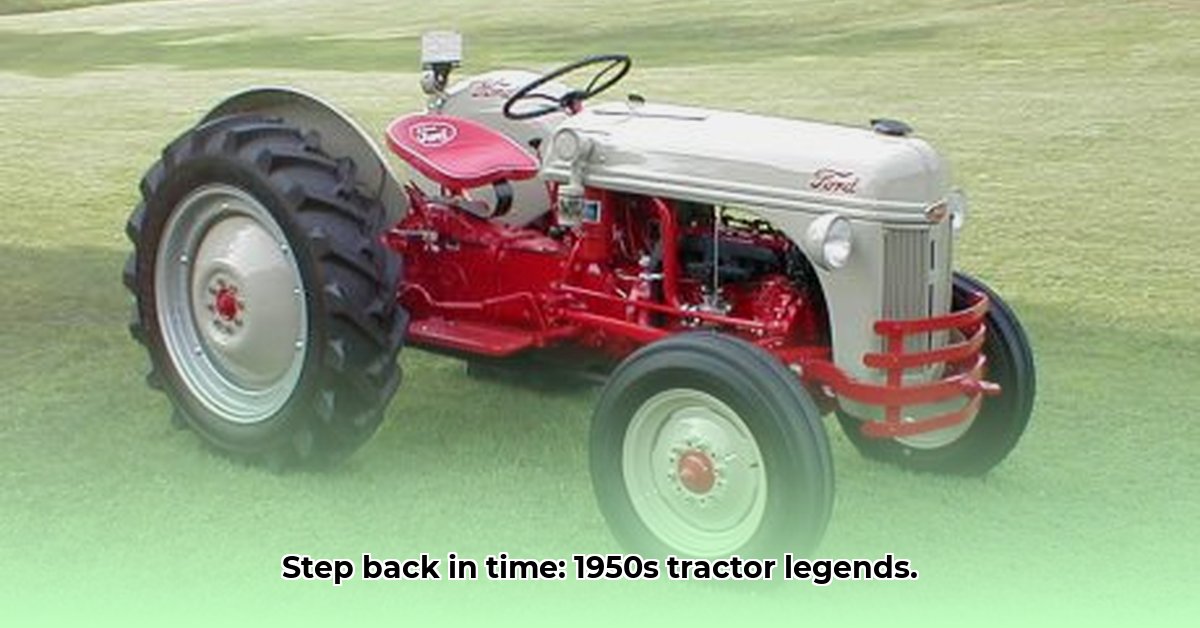
Imagine the rhythmic chug of a powerful engine, the scent of freshly turned earth, and the sheer might of a machine transforming the American landscape. This is the world of 1950s tractors, a pivotal era in agricultural history that saw technological innovation reshape farming forever. This article explores the leading brands, their defining features, and the lasting impact these machines had on agriculture and American culture. We'll uncover the stories behind the iron horses that powered the post-war boom. For more on Allis-Chalmers, check out this great resource: Allis-Chalmers history.
1950s Tractors: A Post-War Agricultural Revolution
The post-World War II era witnessed an unprecedented surge in American agricultural productivity. Farmers, tasked with feeding a burgeoning population, demanded more efficient tools. The 1950s tractor answered this call, offering increased power, innovative features, and dramatically improved efficiency compared to its predecessors. This wasn't merely incremental improvement; it was a revolution in the fields.
The Big Names: A Tractor Lineup for Every Farm
Several manufacturers dominated this agricultural gold rush, each vying for market share with distinct strategies and technological approaches. John Deere, International Harvester, Ford, Allis-Chalmers, and Massey Ferguson emerged as the leading players, each offering tractors tailored to different farm sizes and operational needs.
John Deere: The Green Giant's Rise to Prominence
John Deere's iconic green and yellow machines became synonymous with reliability and durability. Their extensive dealer network ensured widespread availability and strong customer support, solidifying their position as a market leader. "John Deere tractors were more than just equipment; they were an investment in the future of farming," notes Dr. Amelia Hernandez, Agricultural Historian at the University of Illinois. Their legendary longevity built a reputation for quality that persists to this day.
International Harvester: Pioneering Innovation
International Harvester differentiated itself through a commitment to innovation. Their Farmall 400, equipped with the revolutionary Touch-Control Hydraulic System, significantly increased efficiency and ease of operation. This feature, a major technological leap, reduced workload and boosted productivity. "International Harvester's dedication to technological advancement set them apart," explains Professor David Miller, Agricultural Engineering expert at Purdue University. This commitment to innovation significantly impacted future tractor designs.
Ford: Accessibility and Affordability
Ford adopted a straightforward yet effective strategy: producing affordable, versatile tractors accessible to a wide range of farmers. Their user-friendly designs lowered the barrier to entry for those new to complex machinery, making powerful farm technology within reach for smaller operations. "Ford succeeded by providing reliable and approachable technology for the everyday farmer," comments Sarah Chen, a rural economic historian from the University of Wisconsin-Madison. Their practicality fueled widespread adoption.
Allis-Chalmers: Precision Power
Allis-Chalmers distinguished itself by focusing on both power and precision. Their tractors were renowned for their smooth operation and high-quality construction. Farmers appreciated the precise control offered by these machines, ideal for tasks requiring meticulous accuracy. Their performance proved crucial in specialized agricultural applications.
Massey Ferguson: A Global Player
Massey Ferguson's global reach broadened the impact of these agricultural advancements. Their focus on operator comfort and reliability resonated with farmers worldwide. Their tractors epitomized the era’s global expansion of agricultural innovation.
Comparing the Giants: Key Features and Market Positioning
The following table summarizes the distinctive features of each major brand, highlighting their respective strengths and target markets:
| Brand | Key Features | Target Market |
|---|---|---|
| John Deere | Robust build, extensive dealer network, reliability | Farmers of all sizes valuing dependability |
| International Harvester | Innovative hydraulic systems, enhanced efficiency | Larger farms seeking technologically advanced solutions |
| Ford | Affordability, user-friendliness, versatility | Smaller farms and budget-conscious farmers |
| Allis-Chalmers | Powerful, precise operation, high-quality build | Farmers requiring precise control & power |
| Massey Ferguson | Global availability, operator comfort, efficiency | Farmers worldwide seeking reliable machines |
The Enduring Legacy: A Transformative Impact
The tractors of the 1950s represent much more than mere machinery; they symbolize a transformative era in agricultural history. Their increased efficiency played a crucial role in feeding a growing global population. The technological advancements incorporated into these tractors laid the groundwork for future innovations, contributing significantly to modern agricultural practices. Their lasting impact continues to resonate today. Even more research would further illuminate the profound societal changes of this era and the evolution of farming.
How to Compare 1950s Tractor Models: A Buyer's Guide
Choosing a tractor in the 1950s wasn't a simple task. This section provides a framework for comparing models across different brands, highlighting critical aspects to consider.
Power and Performance: Horsepower was a key differentiator, but engine type (gasoline vs. diesel) also played a significant role, influencing torque and starting characteristics.
Design and Features: Transmission type (constant mesh vs. sliding gear), power steering, and the capabilities of the hydraulic systems (including three-point hitches) impacted both efficiency and operator experience.
Brand Reputation and Support: Beyond specifications, consider a manufacturer's reputation for durability, parts availability, and the strength of their local dealer network. A reliable tractor is only as good as the support system behind it.
Assessing Value: Consider factors like repair costs and the availability of parts. These long-term considerations contribute significantly to a tractor's overall value and longevity.
The 1950s tractors were not simply machines; they were instruments of progress, reshaping agriculture and transforming rural life, leaving behind a legacy that continues to inspire and inform.